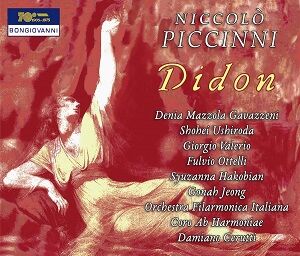
Niccolò Piccinni (1728-1800)
Didon (1783)
Tragédie Lyrique en trois actes
Didon – Denia Mazzola Gavazzeni (soprano)
Enée – Shohei Ushiroda (tenor)
Iarbe – Giorgio Valerio (bass-baritone)
Elise – Gonah Jeong (soprano)
Phénice – Syuzanna Hakobyan (soprano)
Araspe/L’ombre d’Anchise – Fulvio Ottelli (bass)
Orchestra Filarmonica Italiana, Coro Ab Harmoniae/Damiano Cerutti
rec. 2021, l’Auditorium Cavalli Musica di Castrezzato
French libretto with English translation enclosed
Reviewed as download from press preview
Bongiovanni GB 2602/3-2 [2 CDs: 144]
Niccolò Piccinni was one of many successful opera composers during the 18th century whose fame quickly vanished after his death and is today largely forgotten. He was born in Bari, Italy, studied with Leonardo Leo – one of the foremost Italian opera composers from the late Baroque period – and quickly became a leading exponent of the opera buffa genre. His greatest success was La buona figliuola from 1760, which “enjoyed a two-year run in Rome and was played in all the important European capitals. It can probably be called the most popular opera buffa of the 18th century.” Six years later, he was invited by Queen Marie Antoinette to Paris as the first Italian since Lully to write operas for the Académie Royale de Musique. He was successful here, too, and his greatest hit was Didon (1783). It is a Tragédie Lyrique, a through-composed work in three acts with accompanied recitatives, arias, duets choruses and also ballets.
It opens grandiosely with a long overture in three movements. The colourful Allegro maestoso is followed by a beautiful Andante sostenuto, where a solo oboe is featured and then a march-like Allegro sans presser brings the overture to a festive end. The story is well-known through Purcell’s Dido and Aeneas and Berlioz’ Les Troyens.
With only three main characters, Didon, Enée and Iarbe, a heavy burden rests on their shoulders, and since Iarbe disappears halfway into the second act, it is an even more challenging task for the remaining couple. This is of course most obvious in a stage performance, which requires tremendous stamina from the singers. In a studio recording, where the sessions are scattered over several days, it should be more surmountable.
There are lots of dramatic recitatives and arias that cry out for good singing actors, and also several beautiful, melodious outpourings. In the former category, one can mention the scene between Enée and Iarbe and Iarbe’s aria which conclude the first act (CD 1 tr. 13-15), Iarbe’s aria Je veux les voir réduire (CD 2 tr. 2), which is the last we hear of him. In the second category, Didon’s Nous allons la revoir in the first act (CD 1 tr. 5), Enée’s aria Plaignez in Roi (CD 1 tr. 17), Didon’s Ah! Que je fus bien inspire (CD 1 tr. 20) and also in the last act Didon’s Ah! Prends pitié de ma faiblesse (CD 2 tr. 13) – possibly the most beautiful of them all. Several of the choruses are also attractive, and I have only praise for the choral and orchestral contributions.
Alas, the solo singing leaves a lot to be desired. Didon is wobbly, strained, shrill and sorely aged-sounding, although her dramatic intensity is laudable. As for Enée and Iarbe, both are also dramatically apt but also strained and tonally unattractive, and often resort to shouting and – in the case of Iarbe – even barking. I’m afraid I cannot, with the best will in the world, recommend this issue, and regard it as sadly missed opportunity. Fortunately, there exists an alternative recording (Dynamic CDS406), which I haven’t heard, but it is available only as download. For a taster of Piccinni in the shape of an isolated aria from Didon, I warmly recommend Veronique Gens’ recital “Tragédiennes 2” (review).
Göran Forsling
Help us financially by purchasing from





















